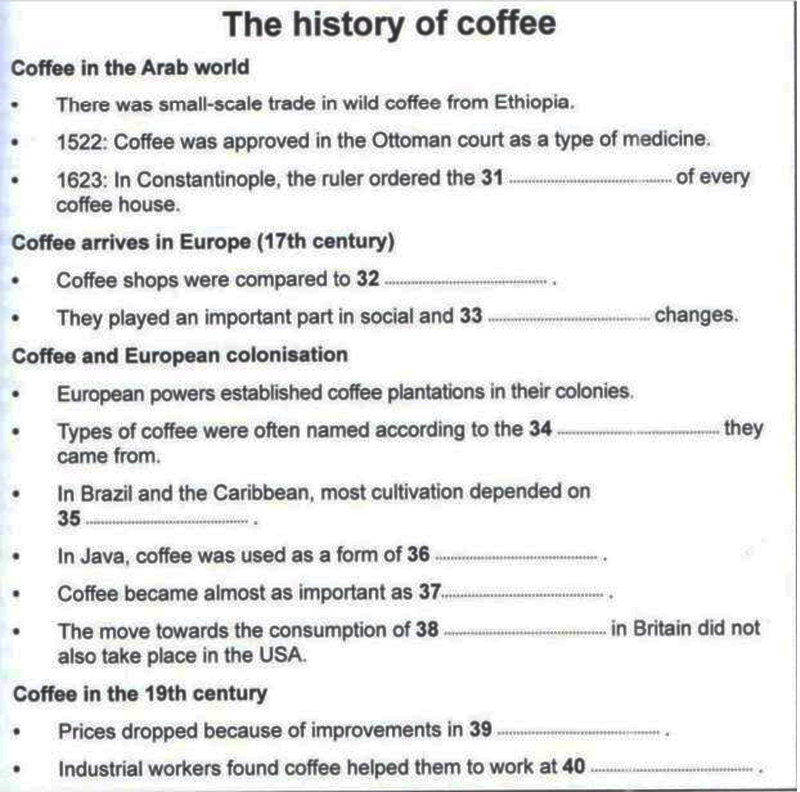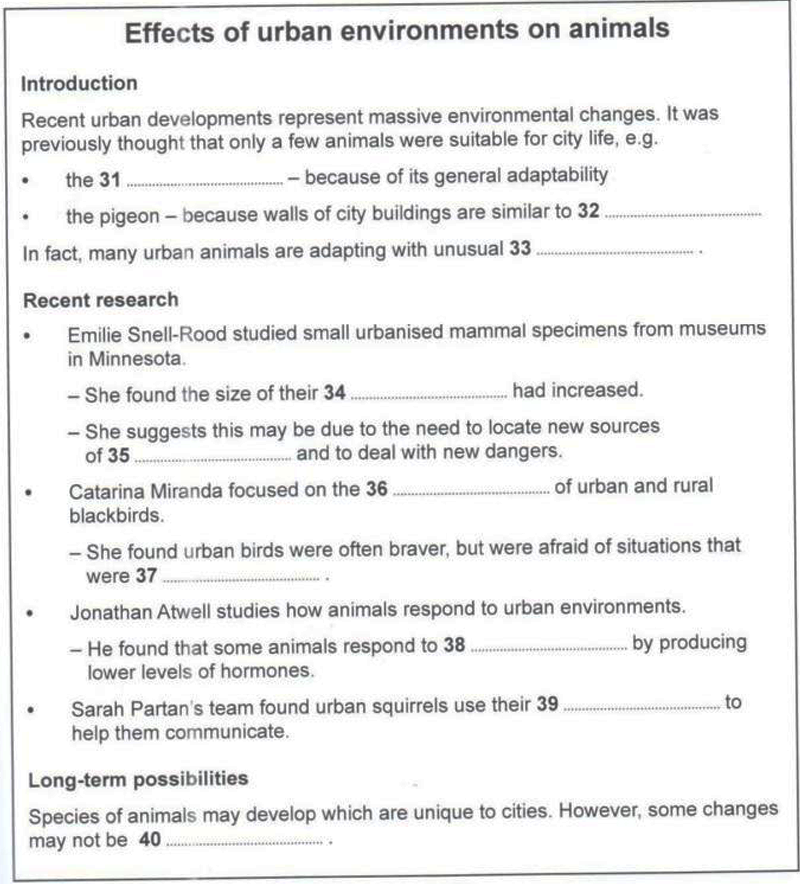Phần 4 của bài IELTS Listening thường không quá khó khăn nếu như thí sinh nắm chắc được kỹ năng nhận biết thông tin đang được paraphrase. Với kỹ năng này, thí sinh không những sẽ dễ dàng nghe được đáp án cần điền mà còn dễ dàng theo dõi được nhiều thông tin xung quanh, phía trước, và phía sau đáp án cần điền, từ đó theo dõi tốt hơn tiến trình của bài nghe.
Trong bài này, chúng ta sẽ cùng phân tích những câu hỏi và đáp án trong Listening Part 4 và chúng được paraphrase như thế nào trong audio script nhé!
Phân tích Paraphrasing trong Part 4
Chúng ta cùng phân tích theo đoạn câu hỏi sau:

Đoạn đầu tiên nói về Coffee in the Arab world, có 2 thông tin quan trọng mà thí sinh cần nghe được trước khi đến với câu hỏi số 31, đó chính là “wild coffee from Ethiopia” và “1552: ... Ottoman ”. 2 câu này nhằm mục đích giúp thí sinh bắt kịp tốc độ và theo dõi tiến trình bài nghe.
Câu 31 trong audioscript như sau: “in 1623 the ruler of Constantinople demanded the destruction of all the coffee houses in the city.” Như vậy, động từ “ordered” = “demanded”, đáp án “destruction”
Trước khi đến với câu 32, bài nghe cũng sẽ phải nhắc đến “Europe” và “17th century”, đó là những từ khóa quan trọng để thí sinh bắt kịp.
Câu 32 trong audioscript như sau: “coffee shops became places where ordinary people, nearly always men, could meet to exchange ideas. Because of this, some people said that these places performed a similar function to universities”. Như vậy, “compared” = “said … similar … to”, đáp án “universities”.
Câu 33 trong audioscript như sau: “many social movements and political developments had their origins in coffee house discussions.” Như vậy, “changes” = “...movements and … developments”, đáp án “political”.
Câu 34 trong audioscript như sau: “the names given to these different types, like Mocha or Java coffee, were often taken from the port they were shipped to Europe from”. Như vậy, động từ “named” = “names given to”, “came from” = “were shipped to Europe from”, đáp án “port”
Câu 35 chắc chắn phải nhắc đến 2 từ khóa rất quan trọng là “Brazil” và “the Caribbean”. Trong audioscript, thông tin như sau: “In Brazil and the various Caribbean colonies, coffee was grown in huge plantations and the workers there were almost all slaves.” Đây là một câu đòi hỏi thí sinh phải hiểu một cách linh hoạt và suy luận thông tin: “những công nhân hầu hết là nô lệ” => “việc canh tác phụ thuộc vào nô lệ”, đáp án “slaves”.
Câu 36 chắc chắn phải có từ khóa “Java”, trong audioscript như sau: “In Java, which had been colonised by the Dutch, the peasants grew coffee and passed a proportion of this onto the Dutch, so it was used as a means of taxation.” Như vậy, “a form of” = “a means of”, đáp án “taxation”.
Câu 37 là một câu dễ nhất trong bài: “it became nearly as important as sugar production” => nearly = almost, đáp án “sugar”
Câu 38 là một câu dài chứa nhiều thông tin và chắc chắn phải nhắc đến “Britain” và “the USA”
“In Britain, however, a new drink was introduced from China … It was tea … it was being widely drunk. However, when the USA gained independence from Britain in 1776, they identified this drink with Britain, and coffee remained the preferred drink in the USA.” => Tea được uống rộng rãi ở Britain, nhưng ở USA, coffee vẫn là loại đồ uống được ưa chuộng nhất => đáp án “tea”
Trước các câu 39 và 40, chắc chắn bài nghe phải nhắc đến “19th century”
Câu 39: “coffee prices started to fall. This was partly because new types of transportation had been developed”. Như vậy, “dropped” = “started to fall”, “improvements in …” = “... had been developed” => đáp án “transportation”
Câu 40: “Working people could afford to buy coffee … they might have to continue throughout the night”. Như vậy, “industrial workers” = “working people” => đáp án “night”
Ví dụ thứ hai:

Đầu bài nghe, có 1 thông tin cực kỳ quan trọng để thí sinh nắm được tiến độ cũng như logic của bài nghe.
“Only a few animals were suitable for city life, e.g” = “Chỉ có 1 số ít loài vật phù hợp với đời sống đô thị, ví dụ:”
Từ đó, ta thấy 2 gạch đầu dòng tiếp theo dc đưa ra (ứng với câu 31 và 32) chính là 2 loài vật được nêu ra làm ví dụ cho câu trên.
Câu 31: chưa rõ loài vật gì, nhưng có đặc điểm là “general adaptability”. Trong audio script: “One species which is well-known as being highly adaptable is the crow.” => Đáp án “crow”
Câu 32: “pigeons” (bồ câu) vì “các bức tường trong thành phố giống như” = “pigeons, because they’re able to perch on ledges on the walls of city buildings, just like they once perched on cliffs by the sea.” => Đáp án “cliffs”
Câu 33: Đây là một câu rất khó, đòi hỏi thí sinh phải nghe và hiểu nội dung của một đoạn dài.
“Many urban animals are adapting with unusual …” = “adaptation by these animals to city life. And one thing that researchers are finding especially interesting is the speed with which they’re doing this - we’re not talking about gradual evolution here - these animals are changing fast”. Thông thường các loài vật sẽ tiến hóa từ từ, nhưng các loài vật trong trường hợp này lại biến đổi với tốc độ nhanh. => Đáp án “speed”
Trước khi đến câu 34, chắc chắn bài nghe phải nhắc đến một cái tên quan trọng đó là “Emilie Snell-Rood”
Câu 34: “the size of their … had increased” = “during that time, these small mammals had experienced a jump in brain size when compared to rural mammals.” => Đáp án “brain”
Câu 35: “the need to locate new sources of … and and to deal with new dangers” = “demands of adjusting to city life - having to look in different places to find food, for example, and coping with a whole new set of dangers.” => Đáp án “food”
Câu 36 gắn liền với một nhân vật và một loài vật cụ thể.: “Catarina Miranda focused on the … of urban and rural blackbirds.”
Trong audio script, cả tên người và tên loài vật đều sẽ được nói đến trong câu văn liền trước, còn câu sau đó: “she has been looking not at their anatomy but at their behaviour” => đáp án “behaviour”
Câu 37 “afraid of situations that were” = “but there’s one type of situation that does seem to frighten the urban blackbirds, and that’s anything new - anything they haven’t experienced before.” => Đáp án “new”
Câu 38 nhắc đến Jonathan Atwell
“Some animals respond to … by producing lower levels of hormones” = “when they’re under stress, their endocrine system react by reducing the amount of hormones” => Đáp án “stress”
Câu 39 nhắc đến Sarah Partan
“Urban squirrels use their … to help them communicate” = “a routine part of their communication is carried out by waving their tails” => Đáp án “tails”
Câu 40 “some changes may not be …” = “it’s possible that not all of these adaptations will be permanent” => Đáp án “permanent”
Các bạn nhớ áp dụng chiến thuật và phân tích để nắm vững Part 4 nhé.
Xem thêm bài viết:
Health problems - Các vấn đề sức khỏe trong IELTS
IELTS Listening chủ đề Food and cooking





